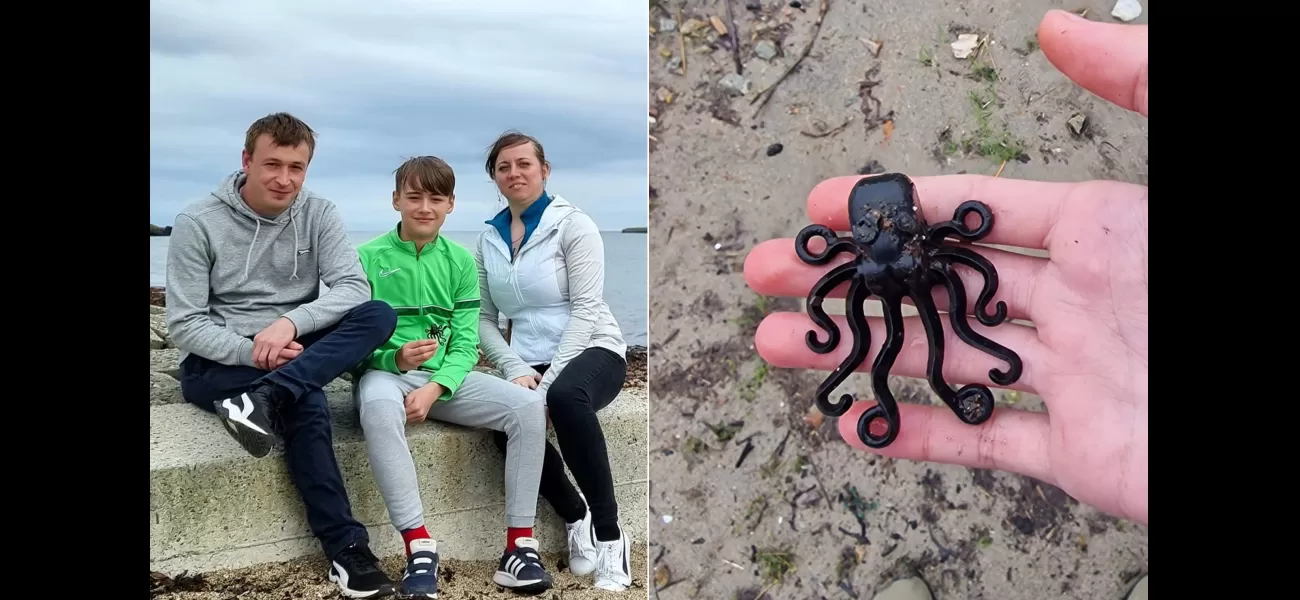After 26 years, a boy discovers a rare Lego octopus on the beach that had fallen into the sea.
Uncommon Lego items continue to appear on Cornwall's beaches.
April 27th 2024.

The ocean is vast and mysterious, holding many secrets and treasures within its depths. One such treasure was recently discovered by a lucky beachcomber - a rare piece of Lego that had been lost at sea for over two decades. This teenage treasure hunter, named Liutauras Cemolonskas, has been on a mission to find this particular Lego piece for the past two years. And finally, after much persistence and patience, he spotted it among the washed-up debris on a beach in Cornwall, England.
Liutauras was overjoyed to finally find the small toy, which had been part of a massive cargo spill in 1997. A rogue wave had caused a ship to lose its containers, including over 5 million pieces of Lego. It was a needle in a haystack situation, but Liutauras was determined to find this lost piece. He explained that he and his family often visit the local beaches, where they also search for fossils and other treasures. In just two years, Liutauras has found almost 800 Lego pieces, a remarkable feat.
But among all the plastic and debris that ended up in the ocean, the octopus piece holds a special place. Only 4,200 of these precious toys were on the ship, making them the most sought-after objects from the spill. Liutauras's goal now is to find one of the 33,941 Lego dragons that were also lost in the accident, 20 miles off the coast of Land's End.
Other beachcombers and visitors have also been on the lookout for these lost Legos. One of them is Tracey Williams, who started the "Lego Lost At Sea" project to document and track the findings of these toys. She herself has found one octopus piece in 1997 and another one just recently, two days after Liutauras's discovery. She explained that the high tide and strong winds during that time caused more of the Lego to wash up on shore, making it an exciting time for treasure hunters.
Tracey has been fascinated by this cargo spill since she first collected some of the Lego pieces near her parents' home shortly after the accident. She even wrote a book about it called "Adrift: The Curious Tale Of The Lego Lost At Sea." She is also conducting research on the spill and its effects, including creating a map to show where the plastic has washed up and what happens to it over time. She hopes to find out if the containers still exist or if they have rusted away, and what has happened to the rest of the Lego that has never been found.
The discovery of these lost Legos is both whimsical and concerning, as it sheds light on the amount of plastic that ends up in our oceans. Tracey admits that it started as a fun hobby, but it has opened her eyes to the larger issue of ocean pollution. She also mentions that Lego is known for its durability, with research suggesting it could survive in the ocean for up to 1,300 years. It's a reminder of how long-lasting our plastic waste can be and the impact it can have on our environment.
In the end, the "Great Lego Spill" of 1997 may have been a mishap, but it has also brought attention to a bigger problem. And thanks to dedicated treasure hunters like Liutauras and Tracey, we are reminded of the importance of taking care of our oceans and reducing our plastic waste. Who knows what other treasures may still be waiting to be discovered?
Liutauras was overjoyed to finally find the small toy, which had been part of a massive cargo spill in 1997. A rogue wave had caused a ship to lose its containers, including over 5 million pieces of Lego. It was a needle in a haystack situation, but Liutauras was determined to find this lost piece. He explained that he and his family often visit the local beaches, where they also search for fossils and other treasures. In just two years, Liutauras has found almost 800 Lego pieces, a remarkable feat.
But among all the plastic and debris that ended up in the ocean, the octopus piece holds a special place. Only 4,200 of these precious toys were on the ship, making them the most sought-after objects from the spill. Liutauras's goal now is to find one of the 33,941 Lego dragons that were also lost in the accident, 20 miles off the coast of Land's End.
Other beachcombers and visitors have also been on the lookout for these lost Legos. One of them is Tracey Williams, who started the "Lego Lost At Sea" project to document and track the findings of these toys. She herself has found one octopus piece in 1997 and another one just recently, two days after Liutauras's discovery. She explained that the high tide and strong winds during that time caused more of the Lego to wash up on shore, making it an exciting time for treasure hunters.
Tracey has been fascinated by this cargo spill since she first collected some of the Lego pieces near her parents' home shortly after the accident. She even wrote a book about it called "Adrift: The Curious Tale Of The Lego Lost At Sea." She is also conducting research on the spill and its effects, including creating a map to show where the plastic has washed up and what happens to it over time. She hopes to find out if the containers still exist or if they have rusted away, and what has happened to the rest of the Lego that has never been found.
The discovery of these lost Legos is both whimsical and concerning, as it sheds light on the amount of plastic that ends up in our oceans. Tracey admits that it started as a fun hobby, but it has opened her eyes to the larger issue of ocean pollution. She also mentions that Lego is known for its durability, with research suggesting it could survive in the ocean for up to 1,300 years. It's a reminder of how long-lasting our plastic waste can be and the impact it can have on our environment.
In the end, the "Great Lego Spill" of 1997 may have been a mishap, but it has also brought attention to a bigger problem. And thanks to dedicated treasure hunters like Liutauras and Tracey, we are reminded of the importance of taking care of our oceans and reducing our plastic waste. Who knows what other treasures may still be waiting to be discovered?
[This article has been trending online recently and has been generated with AI. Your feed is customized.]
[Generative AI is experimental.]
0
0
Submit Comment





